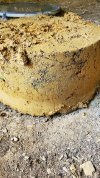There are a handful of ponds nearby, some hold water, some don't. definiteley hit or miss. Most of them are pretty crude, shallow affairs where a farmer just starts pushing dirt into a berm to make a hole where his cattle can get a drink if water happens to collect in the hole. Within half a mile the neighbor has one full pond and one dry one. Both have veins of rock sticking out of the bottoms.The core trench usually extends 3-10’ deep below what was the original ground surface. The purpose is to interrupt any paths for water along or just below the surface (roots, varmint tunnels, old pipes/wires, etc.) The clay core itself starts at the bottom of this trench and goes up all the way to above the water level, and simply acts as a ‘last resort’ to seal any leaks. The other part, depending on what type of overflow, is to have anti-seep collars around the overflow pipe going through the dam. Again to prevent water from following the edge of the pipe through the dam.
Are there other successful ponds near by?
My pond was built as an aesthetic feature or maybe for fish as the previous owner left some huge boulders stacked up attractively for fish structure or for birds to light upon? The sellers were doctors, not farmers. The dam looks engineered to me and has a siphon system for the overflow so there is no pipe penetrating the base of the dam. There is also a small spillway thing at one edge that is lined with rocks as a second overflow.




